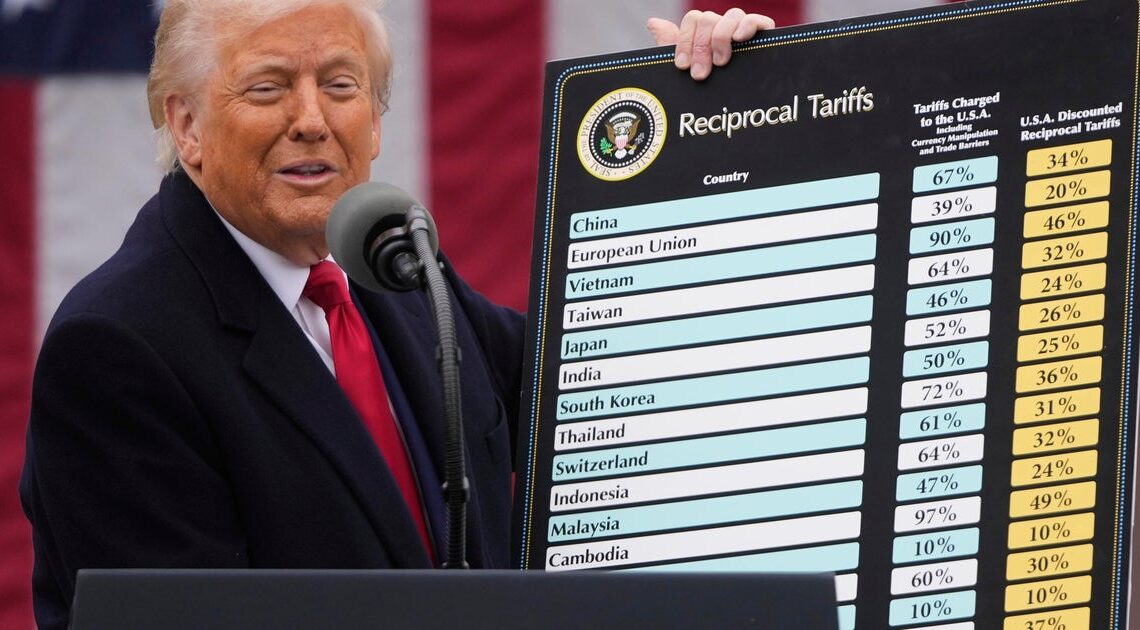
Which products will be affected by tariffs? Here’s what Trump’s “Liberation Day” could make pricier.
2. April 2025 [ad_1]
Inflation-weary Americans may soon find they’re paying more for a host of products after President Trump announced two new types of tariffs on April 2, a day he termed “Liberation Day” because he believes the measures will erase trade imbalances between the U.S. and other nations.
While Mr. Trump characterizes tariffs as paid by other nations, they are in fact paid by U.S. importers, such as Walmart or Amazon. Because the tariffs create higher costs for those businesses, they typically pass on all or some of the tariffs to consumers through price hikes.
The new tariffs introduced by Mr. Trump on Wednesday include a 10% universal tariff, as well as so-called reciprocal tariffs on 60 countries that are trade partners with the U.S. The tariffs will be additive, meaning that imports will face both the universal tariff of 10% plus the specific reciprocal import levies targeting each nation.
During his announcement, Mr. Trump’s said the tariffs will would eventually lower prices for Americans, an issue on which voters say they want him to focus. But economists are predicting instead that consumers and businesses will likely encounter higher inflation, with price hikes on everything from food imports like coffee and chocolate to iPhones and other electronics manufactured outside the U.S.
“For all of President Trump’s talk of a new ‘golden age,’ this huge tax increase will inevitably result in higher prices for American families, lower growth and business investment, and diminished exports and manufacturing output as the country’s factories face retaliation abroad and costlier inputs (roughly half of all imports) at home,” said Scott Lincicome and Colin Grabow, trade experts at the Cato Institute, in an email.
They added, “With today’s announcement, U.S. tariffs will approach levels not seen since the Smoot-Hawley Tariff Act of 1930, which incited a global trade war and deepened the Great Depression.”
The Trump administration said there are some exclusions to the tariffs, including semiconductors, pharmaceuticals and critical minerals, although it added that these products might be subject to tariffs at a later time.
Which products will become more expensive with tariffs?
Because of the 10% universal tariff on imports, any imported good is likely to become more expensive in the coming weeks and months as American companies digest the import duties and adjust their prices in response.
For instance, after Mr. Trump added tariffs to imported washing machines during his first term, the median price of an appliance jumped more than 11%, adding about $86 to the cost of a new unit, according to University of Chicago researchers.
Electronics like iPhones and TVs
Among the nations targeted by Mr. Trump’s reciprocal tariffs are China, Taiwan and South Korea, who are top exporters of electronics to the U.S., from Apple iPhones to television sets.
The Trump administration plans to hit China with a reciprocal tariff of 34%, which means that products manufactured there and imported into the U.S. could see higher prices soon after the levies go into effect on April 9.
Almost all iPhones are still manufactured in China, according to the Council on Foreign Relations, although Apple has shifted some of its iPhone fabrication to India. However, the Trump administration will also be adding a 26% reciprocal tariff to Indian imports, it said on Wednesday.
“Apple produces basically all their iPhones in China and the question will be around exceptions/exemptions on this tariff policy if those companies are building more operations/factories/plants in the U.S.,” said Wedbush analyst Dan Ives in an April 2 research note.
Automobiles
In addition to Mr. Trump’s previously announced 25% tariff on auto imports, which go into effect today, imported autos will also face the 10% universal tariffs. Some U.S.-made vehicles include parts imported from other countries, which will face new tariffs and increase the purchase price of those cars, experts said.
Ultimately, American consumers could end up paying an additional $2,500 to $5,000 for the lowest-cost American cars, and up to $20,000 for some imported models, according to an April 2 estimate from Anderson Economic Group.
Clothing and shoes
The bulk of apparel and shoes sold in U.S. stores like Walmart and Target is manufactured outside the U.S., with China, Vietnam and Bangladesh among the biggest exporters.
All three nations will face reciprocal tariffs from the Trump administration, at 34% for China, 46% for Vietnam and 37% for Bangladesh.
Wine and spirits
Italian and French wines and Scottish whisky are also likely to rise in price, as European Union imports will face a reciprocal tariff of 20% while United Kingdom-made products will face a 10% import duty.
Furniture
About 30% to 40% of furniture sold in the U.S. is manufactured in other countries, according to CNBC. Top exporters of furniture to the U.S. include China and Vietnam.
Coffee and chocolate
The U.S. imports about 80% of its coffee beans from Latin American countries such as Brazil and Colombia, according to the U.S. Department of Agriculture. Both nations are included in Mr. Trump’s reciprocal tariffs, with each facing rates of 10%.
Chocolate is another major Latin American import, given that the U.S. climate is by and large unsuited to growing cocoa beans. Among the nations that export cocoa beans to the country are Cote d’Ivoire and Ecuador, according to the USDA. Those nations will face reciprocal tariffs of 21% and 10%, respectively.
Swiss watches
Swiss imports to the U.S. will face a new reciprocal tariff of 31%, which will impact watches from affordable brands such as Swatch to pricey timepieces manufactured by the likes of Rolex.
[ad_2]
Source link